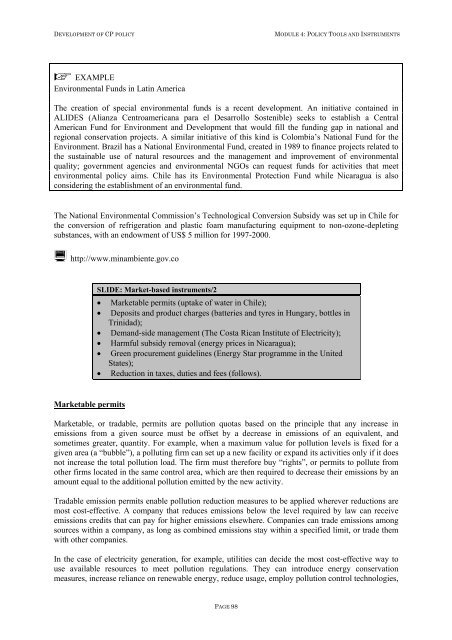Manual on the Development of Cleaner Production Policies ... - Unido
Manual on the Development of Cleaner Production Policies ... - Unido
Manual on the Development of Cleaner Production Policies ... - Unido
Create successful ePaper yourself
Turn your PDF publications into a flip-book with our unique Google optimized e-Paper software.
DEVELOPMENT OF CP POLICY<br />
MODULE 4: POLICY TOOLS AND INSTRUMENTS<br />
EXAMPLE<br />
Envir<strong>on</strong>mental Funds in Latin America<br />
The creati<strong>on</strong> <strong>of</strong> special envir<strong>on</strong>mental funds is a recent development. An initiative c<strong>on</strong>tained in<br />
ALIDES (Alianza Centroamericana para el Desarrollo Sostenible) seeks to establish a Central<br />
American Fund for Envir<strong>on</strong>ment and <strong>Development</strong> that would fill <strong>the</strong> funding gap in nati<strong>on</strong>al and<br />
regi<strong>on</strong>al c<strong>on</strong>servati<strong>on</strong> projects. A similar initiative <strong>of</strong> this kind is Colombia’s Nati<strong>on</strong>al Fund for <strong>the</strong><br />
Envir<strong>on</strong>ment. Brazil has a Nati<strong>on</strong>al Envir<strong>on</strong>mental Fund, created in 1989 to finance projects related to<br />
<strong>the</strong> sustainable use <strong>of</strong> natural resources and <strong>the</strong> management and improvement <strong>of</strong> envir<strong>on</strong>mental<br />
quality; government agencies and envir<strong>on</strong>mental NGOs can request funds for activities that meet<br />
envir<strong>on</strong>mental policy aims. Chile has its Envir<strong>on</strong>mental Protecti<strong>on</strong> Fund while Nicaragua is also<br />
c<strong>on</strong>sidering <strong>the</strong> establishment <strong>of</strong> an envir<strong>on</strong>mental fund.<br />
The Nati<strong>on</strong>al Envir<strong>on</strong>mental Commissi<strong>on</strong>’s Technological C<strong>on</strong>versi<strong>on</strong> Subsidy was set up in Chile for<br />
<strong>the</strong> c<strong>on</strong>versi<strong>on</strong> <strong>of</strong> refrigerati<strong>on</strong> and plastic foam manufacturing equipment to n<strong>on</strong>-oz<strong>on</strong>e-depleting<br />
substances, with an endowment <strong>of</strong> US$ 5 milli<strong>on</strong> for 1997-2000.<br />
http://www.minambiente.gov.co<br />
SLIDE: Market-based instruments/2<br />
• Marketable permits (uptake <strong>of</strong> water in Chile);<br />
• Deposits and product charges (batteries and tyres in Hungary, bottles in<br />
Trinidad);<br />
• Demand-side management (The Costa Rican Institute <strong>of</strong> Electricity);<br />
• Harmful subsidy removal (energy prices in Nicaragua);<br />
• Green procurement guidelines (Energy Star programme in <strong>the</strong> United<br />
States);<br />
• Reducti<strong>on</strong> in taxes, duties and fees (follows).<br />
Marketable permits<br />
Marketable, or tradable, permits are polluti<strong>on</strong> quotas based <strong>on</strong> <strong>the</strong> principle that any increase in<br />
emissi<strong>on</strong>s from a given source must be <strong>of</strong>fset by a decrease in emissi<strong>on</strong>s <strong>of</strong> an equivalent, and<br />
sometimes greater, quantity. For example, when a maximum value for polluti<strong>on</strong> levels is fixed for a<br />
given area (a “bubble”), a polluting firm can set up a new facility or expand its activities <strong>on</strong>ly if it does<br />
not increase <strong>the</strong> total polluti<strong>on</strong> load. The firm must <strong>the</strong>refore buy “rights”, or permits to pollute from<br />
o<strong>the</strong>r firms located in <strong>the</strong> same c<strong>on</strong>trol area, which are <strong>the</strong>n required to decrease <strong>the</strong>ir emissi<strong>on</strong>s by an<br />
amount equal to <strong>the</strong> additi<strong>on</strong>al polluti<strong>on</strong> emitted by <strong>the</strong> new activity.<br />
Tradable emissi<strong>on</strong> permits enable polluti<strong>on</strong> reducti<strong>on</strong> measures to be applied wherever reducti<strong>on</strong>s are<br />
most cost-effective. A company that reduces emissi<strong>on</strong>s below <strong>the</strong> level required by law can receive<br />
emissi<strong>on</strong>s credits that can pay for higher emissi<strong>on</strong>s elsewhere. Companies can trade emissi<strong>on</strong>s am<strong>on</strong>g<br />
sources within a company, as l<strong>on</strong>g as combined emissi<strong>on</strong>s stay within a specified limit, or trade <strong>the</strong>m<br />
with o<strong>the</strong>r companies.<br />
In <strong>the</strong> case <strong>of</strong> electricity generati<strong>on</strong>, for example, utilities can decide <strong>the</strong> most cost-effective way to<br />
use available resources to meet polluti<strong>on</strong> regulati<strong>on</strong>s. They can introduce energy c<strong>on</strong>servati<strong>on</strong><br />
measures, increase reliance <strong>on</strong> renewable energy, reduce usage, employ polluti<strong>on</strong> c<strong>on</strong>trol technologies,<br />
PAGE 98
















